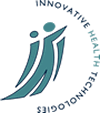IHT Annual Meeting 2002
1st Annual Meeting 18-19 April 2002
City University, London
The first Annual Meeting of the Innovative Health Technologies Programme was held on April 18-19 2002 at the City University in London. Researchers from both Phase I and II of the Programme attended as well as colleagues from the ESRC and MRC Offices. The sixty-five delegates came together for a two-day meeting that gave everyone the chance to get to know each other's work and to discuss generic issues that cut across the Programme.
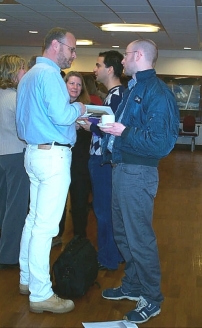 |
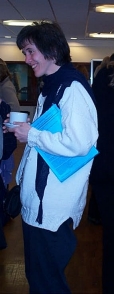 |
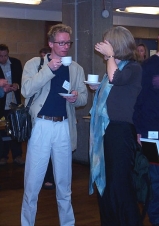 |
| John Imrie & Paul Flowers | Frances Griffiths | Nik Brown & Sally Wyatt |
The Programme Director, Professor Andrew Webster, opened the proceedings with a short review of the programme and the objectives for the two days. He reported that the Programme now numbers 135 researchers, from a range of social science and clinical disciplines, based in 45 institutions, and stressed how the Programme sought to engage with health technologies in a critical but constructive way.
Medical technologies are, as Stuart Blume has recently noted, both 'effective and problematic', yet as the projects are already beginning to demonstrate, the very efficacy of medical interventions often creates new problems. Current and future medical technologies are evaluated through health technology assessment and horizon scanning, as well as filtered at the clinical level by the subscription to 'evidence based medicine'. While these play a central role in the allocation of health resource and the shaping of health practice, the IHT Programme suggests that they may be poor predictors of both the (social) value of new technologies and the nature of the population(s) that access new technologies (so posing logistical and regulatory problems for health policy). In terms of this second question, IHTs that combine both diagnostic and predictive tests draw an increasingly large asymptomatic population into the orbit of medicine; at the same time, more and more people can access health information outside of the orbit of medicine (via the Web, for example) creating more complex demand-management problems for health services. The Annual Meeting provided a good opportunity to explore these issues through a number of core organising themes: risk, the social management of health, innovation and governance, as reported below.
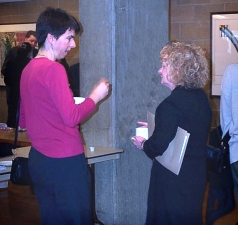 |
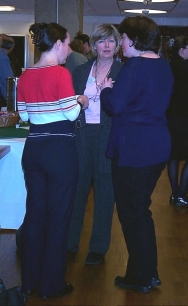 |
| Jane Seymour & Eileen Green | Tracy Williams, Gloria Lankshear & Maggie Mort |
The meeting also set aside some time for a few presentations from Phase
I projects and a short summary by a colleague from each of the new Phase
II projects. Simon Cohn opened up the presentation session on Day 1 with
an account of his project on novel imaging techniques being deployed in
neurology, illustrating his talk with an impressive array of static and
mobile brain images, including his own!
Simon reported that the 3D brain imaging work is encouraging researchers
to redefine the basis of mental illness towards a physical set of properties
that allow for new forms of classification of disease. This is not transgressive
but rather constructs new 'authoritative' ways of confirming established
biomedical models of illness. There is however a shift away from diagnoses
as derived from expert-lay talk and interaction towards an apparently objective
rendering of the source of 'the problem'.
David Armstrong continued the Phase I presentations offering a summary of his findings so far from his team's project on the meaning and use of 'quality of life' measures, and the way these shape judgements made about IHTs. QoL measures appeared for the first time in the 1970s, and there are now nearly 40,000 citations to QoL with over 500 different instruments currently in use. The measures have moved from being indicators of social progress, outcomes of care, to today's emphasis on their being arbiters of technical 'success' (e.g. debates surrounding the technical ability to sustain life vs. the quality of that life). David offered an interesting argument about the relationship between symptom and illness, as this has changed since the 18th century, suggesting that today the way clinicians interpret the significance of symptom is through reference to quality of life measures. Over the next 12 months the team will be investigating how the different types of QoL measures play different roles in different IHT areas, shaping determinations of technical and clinical utility.

Everybody gathers together for the rapporteur sessions
All the new Phase II project teams gave synopses of their proposed research. These projects focus on core Themes of the Programme that were underdeveloped in the first Phase, notably innovation, regulation and social inclusion/exclusion, and have a stronger international coverage. Alan O'Rourke provided an account of internet pharmacy and the acquiring of drugs via the Web, Andrew James offered a summary of the Manchester-based project exploring the uneven innovation paths associated with ophthalmology and cardiology, Sarah Nettleton described her project relating to e-based health (re)sources used by families in the management of chronic illnesses such as asthma and diabetes, and Carl May provided a review of the new project his team is to pursue on teledermatology and the risk implications it may have. Joe Cullen's project looks at collaborative knowledge systems and the possibility of lay empowerment through anecdotal evidence-based forms of knowledge for health promotion and support; Phil Tovey and his team are to examine complementary and alternative medicine in both the UK and Pakistan and the ways in which CAM is mediated by social context of use (rather than simply at the level of the individual user), focussing on a variety of cancer user groups at different stages of the disease. The emergence of tissue engineering in the UK and EU is to be explored by the Cardiff-based project led off by Alex Faulkner with a specific emphasis on the regulatory and governance questions it poses: the potential market for this new IHT is huge (in areas such as skin systems, cartilage and bone, vascular prostheses and tissue for reconstruction) yet it is growing in a regulatory vacuum in the absence of which considerable 'proto-regulatory' activity is being undertaken. The ways in which people engage with contemporary genetics is to be examined by Anne Kerr and Richard Tutton at York in their project that explores the notion of 'genetic subjecthood': Anne discussed the multiplicity of ways in which we confront and negotiate the use of genetic information, in terms of the donation, ownership and control of genetic data (for example in relation to the patenting of patients' DNA or the lodging of personal information in new DNA repositories at a national level). These create different notions of genetic subjecthood that might be in conflict, that might be mobilised in different ways and that relate to people's social location. Paul Martin reported on his project on innovation in pharmacogenetics and the implications this has for the R&D path in the industry and the nature of the drugs market (more customised and personalised). The study involves international comparative work and has a strong focus on SME/large Pharma linkage. Finally, David Clark summarised the new work that follows on from his colleagues' Phase I project on 'natural death', here a project that maps the changing clinical and public health notions of innovation and pain relief as used to manage cancer patients.
Generic themes
The meeting gave Programme members a chance to discuss some of the main themes that shaped the research specification from the start: here we concentrated our attention, because of limitations of time, on risk, regulation, innovation and the social management of health, with sub-groups of delegates dividing off to discuss these at different times during the meeting. Some of the main ideas that merged from these debates are summarised here.
Risk
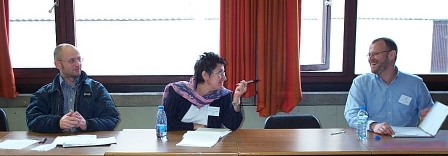
Paul Flowers, Gillian Hundt, John Imrie
Within the two risk subgroups a wide range of issues were identified that were common to all the projects involved. Risk has become a key issue and is currently being addressed by the ESRC/MRC in a review of the literature as it relates to health. The IHT projects will be able to make an important contribution towards this wider debate since many are already picking up on themes the review has identified as important for future research. Some key points made by the rapporteurs of the subgroups were as follows:
- in response to the notion of risk culture, many people are looking for certainty and creating new narratives for this
- risk is a highly contested issue and may be used by different social groups in different ways such that we need to know how risk information is transmitted and translated between them
- the 'professional' rendering of patient risk is unhelpful, failing to understand the actual dilemmas patients face
- what is the patient's meaning of risk? Is it social or statistical and does it depend on time and space? How risk is presented affects how patients perceive risk; for example, some patients think that a 10% chance of becoming ill is less risky than a 1 in 10 chance of becoming ill, even though they are the same probabilities
- health professionals now often transfer risk management onto their patient i.e. the 'informed patient' who has to make a choice to have a treatment or not; this also reflects a wider institutional process whereby resources are being allocated less on the basis of need and more on the basis of risk
- finally, some projects are seeing that patients' trajectories of care move down different pathways that carry critical junctures: respondents report that they often have little sense of control over how fast and in what direction one moves
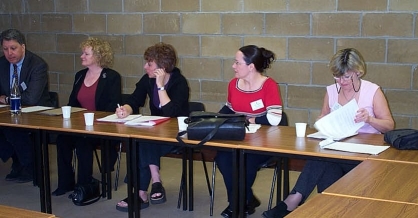
Lindsay Prior, Eileen Green, Flis Henwood, Tracy Williams, Gloria Lankshear
Governance
Governance covers regulatory regimes and globality. Three projects on genetics,
pharmaceuticals and tissue engineering devices, are 'regulatory', and they
are to analyse the regulatory apparatus and relationships, with systematic
comparisons to other countries. Other projects on women's midlife IHT's,
genetic subjecthood and telemedicine look at governance as a matter of negotiation
and health understanding. How is governance formed in practice and does
it limit understanding? What is the legitimate role of different groups
within this process, and especially the role of expertise? How does individual
choice and consumerism subvert/alter possibilities in relation to practice?
Initial conclusions shared across the different projects included:
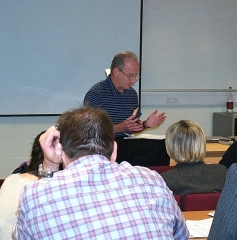
Brian Salter
- we need to link regulation of IHTs to a wider debate related to citizenship and governance
- comparatively, IHTs vary in different countries so in regulatory terms they might not be the same entities - this poses problems at a European health policy level - when, for example is someone a 'human being' varies from country to country (in regard to legislation on reproductive science and human rights)
- the dynamics of consumerism and individualism alter the relations of governance of IHTs
- trust in expertise needs to be related to new forms of trust in the growing numbers of intermediaries involved in the management and delivery of health services, especially as a result of government policy to 'join-up' services
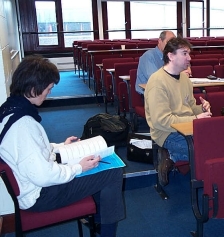 |
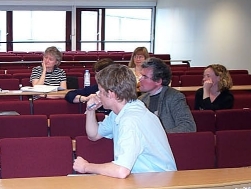 |
| Frances Griffiths, Alex Faulkner, John Abraham | Jackie Goode, Maggie Mort, Andy McMeekin, Gillian Robinson, Alan O'Rouke, Anne Kerr |
Innovation
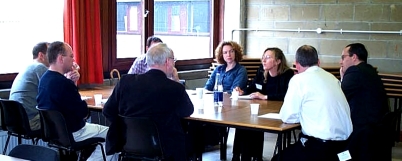
Paul Nightingale, Paul Martin, Nick Watson, David Armstrong, Rachel Grellier,
Julie Anderson, David Clark, Jo Cullen
The Programme has a range of projects that focus on innovation dynamics, especially in Phase II. The meaning of innovation is central to the Programme and the projects are trying to track its social construction in different settings. Does it, for example, manifest itself in a new 'machine' or in a process or event? What does seem to happen is that for almost all of the projects the innovations under scrutiny the point of clinical intervention occurs much earlier than in the past. We might want to characterise this as a new generic form of medicine that mixes both predictive and increasingly targeted styles of diagnosis and delivery. The innovation sub-group drew attention to various points from this, including:
- the innovation processes work along different time frames and involve users in more, or less, direct engagement with the new technologies, such that it is increasingly impossible to draw clear boundaries between the demand and supply 'sides' of the innovation equation
- quality of life measures shape innovation, both in rhetorical and material ways, positioning IHTs such that they might benefit from new markets
- surgical procedures are happening much earlier in the clinic as a result of the spread of imaging and other revelatory tools; surgery becomes more akin to clinical engineering
- finally, innovation appears to be increasingly 'protocol driven'
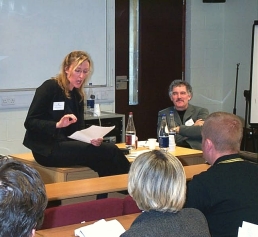
Julie Anderson
The Social Management of Health
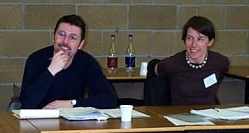
Gerry Hanlon & Sarah Nettleton
The final subgroup discussed the ways in which IHTs recast the social management
of health: since this is another way of describing the social management
of social relationships project members stressed that early findings indicate
that this is not merely a matter of managing 'a condition'. Health issues
are also captured by different social groups and there is considerable social
movement around an issue, such as screening for cancer. Moreover, health
is managed through an informal peer review system where new technologies
are also creating new types of health users/communities.
Among the various points raised in detail were:
- how technology gets implemented is highly context specific, depending on the local institutional and cultural arrangements in place at any one time
- the management of health is driven by information seeking which might confirm or change an individual's perspective: patients are seen to be moving outside of the NHS to negotiate their health needs leading to a 'tapestry' of different users and consumers
- there is a diffusion and distribution of responsibility and risk outside of the medical profession that leads to a risk individualisation
- definitions of illness are both economic and political and the projects are picking this up through, for example, use of risk as a threshold for the receipt or withdrawal of services
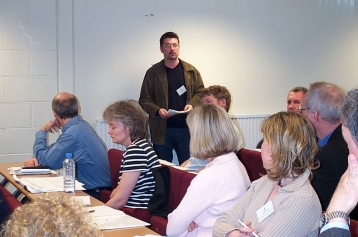
Gerry Hanlon
Trans-Programme issues
There were three areas that were debated at the meeting that are to be explored through more intensive discussion via the Programme's own discussion list. The three areas were, first patient pathways, used unevenly throughout the NHS and based upon multi-professional input in managing a patient's trajectory; the government is currently trying to secure authenticated routes with clear choices at specific stages of recovery. The projects on the IHT programme are mapping the ways in which these trajectories do, or do not, tie up with patients; own pathways. Patients appear to be moving down multiple pathways at the same time. The second area related to the evaluation of IHTs, and here the groups stressed that the IHT Programme will have different sorts of impact on understanding, policy and practice and that the most impact may derive as much from the first as from the other two. Finally, the information group examined the meaning of informed consent and the informed patient and sought to stress the ways IHTs were redefining the meaning of both. More on these trans-Programme issues will appear on the IHT web site as part of a wider discussion paper.
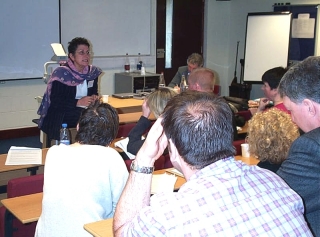
Gillian Hundt
Close of meeting
The meeting closed with the Director and Stephanie Gant, Programme Administrator outlining future plans for new cluster meetings, dissemination and the building of interuser networks. On the first of these, for example, there is a meeting planned at Brighton in October 2002 on ICTs and health that brings together the ESRC and EPSRC work in the area. Similar meetings relating to genetics and reproductive technologies are planned, including one to be hosted at GSK in the autumn.
